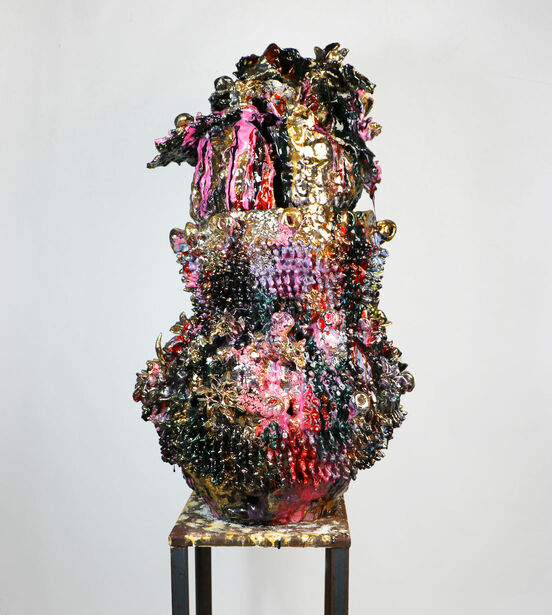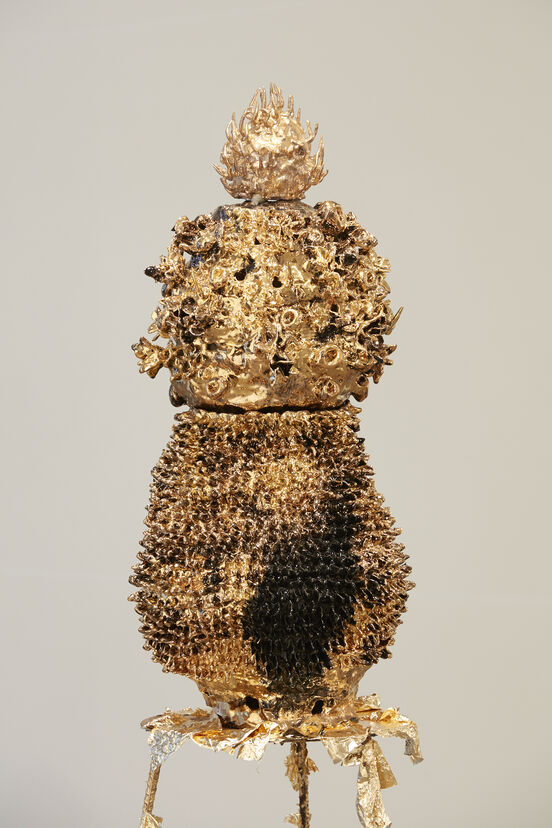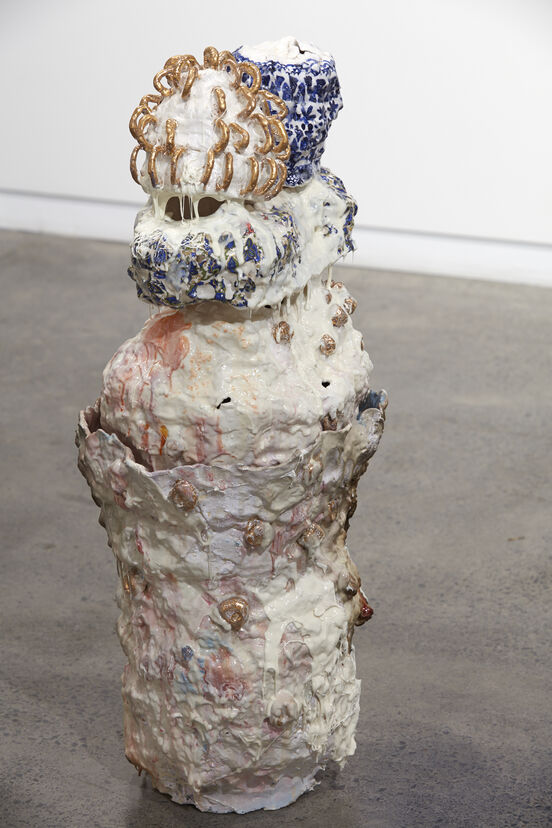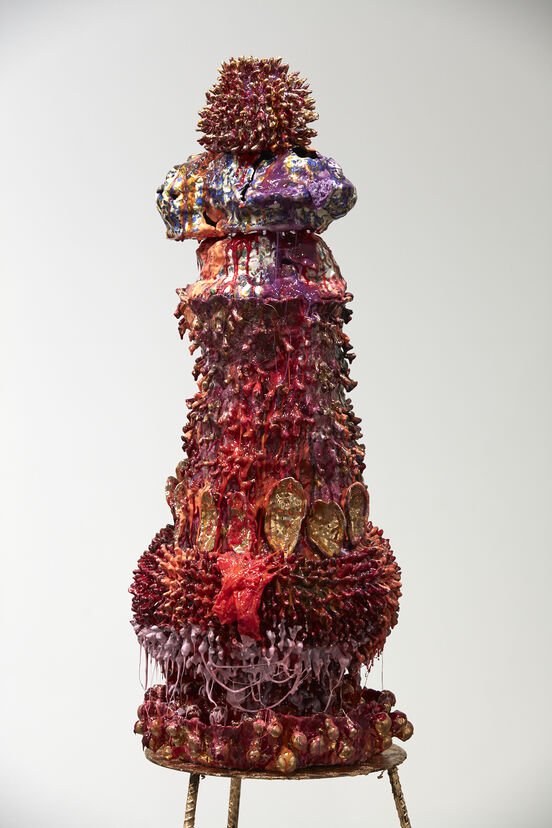-
Author
Becky Richards -
Date
4 Nov 2021
Essay
Glorious Creatures
Body image and the sculptures of Virginia Leonard
The large-scale work by artist Virginia Leonard All I Want Is a Facelift (2018) lived in the Objectspace courtyard for more than a year. Every Sunday, my shift of solo gallery minding, I would unlock our gate, and nod it a greeting, sometimes risk a cheery “Good morning!”, hoping that no passers-by would notice I was talking to a sculpture. The ceramic piece had such a strong animate quality, and figurative character, that it truly felt like company. A body, lumpy, glowing and oozing; full-bellied, studded with nodules, crowned by a thick, rounded head. Its bulk was slathered in gold lustre, streaming with runs of hot-pink and black resin. I loved it. I felt like I’d lost a friend when the time came for the thing to move on.
I’m effusive in my appreciation for the shape and textures of All I Want Is a Facelift (as I am for many of Leonard’s large-scale works), and I often read them as bodies, as sentient things with an attitude. But I’ve noticed there’s a glitch in my thinking when it comes to physicality: a gulf between how I perceive sculptural forms and my own shape.
Gazing at that beautiful monster in the courtyard, I found its generous, asymmetric proportions glorious, its layered imperfections appealing. Yet when I look in the mirror after a shower, an entirely different mode of body viewing starts up – bulges or lumpiness elicit knee-jerk revulsion. Like so many others, I carry an inherited standard of the female form that is unforgivingly streamlined – idealising a type of smoothness and uniformity that would bore me senseless in a sculpture.
There’s a felt, formal discrepancy between these two ways of looking. The stare in the mirror that meets my reflection is hard-edged and narrow, holding to a stale, teenage changing-room angst; whereas my sculptural eyes are hungry for abundant shapes, morphic growthiness, protrusions. This stark difference is rooted in the origins of each perspective. An aesthetic sensibility is something I’ve been able to cultivate, tended slowly through years of wide-open curiosity. The scaffolding that rises when I look at my own thighs, however, wasn’t self-built but erected around me, bolted together by Dolly magazine, Weight Watchers tuna bake and high school diet pacts. How would I look at my body if I’d never been handed that rule book?
From viewing to making, liberation from calcified aesthetic guidelines can create a springboard for innovation, a ground for fresh ways of thinking and doing. In a 2017 interview with Sue Gardiner for Art Collector, Leonard stated, “Not knowing traditional ceramic rules was an advantage for me. I could push hard up against conventions, and approach clay in a more reckless and fearless manner”.1 Operating beyond the bounds of what’s deemed ceramic-appropriate has allowed Leonard to construct huge, precarious sculptures, and develop a unique arsenal of techniques and materials. She transforms studio pottery staples like stoneware clay bodies and glaze with post-firing applications of thick resin, challenging notions of purity in ceramic processes. Common methods of coil and slab construction are stretched to gravity-defying limits and employed with a loose ferocity, emphasising the maker’s actions and the physical properties of clay.
Leonard’s sculptures demonstrate the generative potential of working without a blueprint. I’m trying to picture a similar blank slate for self-image, free from all socio-cultural constructs of ideal female bodies. A bare plot, where I’m the sole architect of how I see my form. Here it would be possible to build original thought structures – unbounded, organic and flourishing. Without rigid outlines or checkboxes, perhaps I could grow a fresh relationship with my body – one that is both expansive and intricate – breaking ‘the rules’ like Leonard’s creations.
*
There’s an animate vitality present in Leonard’s work. Some pieces are so lively they emit a bold sense of awareness. Take You Lead and I Will Not Follow (2018) – this rotund black and gold creature doesn’t give a toss about the judgements of any viewer; her thick coat of lustre reflects light with brash dignity. I can imagine the sculpture glancing at her reflection, and thinking, “What a fabulous thing I am.”
But boundary-defying confidence in female bodies carries a history of reproach. In her critique of the female grotesque, theorist Mary Russo cites the well-worn statement “She is making a spectacle out of herself”, delivered with condescending disapproval:
‘For a woman, making a spectacle out of herself had more to do with a kind of inadvertency and loss of boundaries: the possessors of large, aging and dimpled thighs displayed at the public beach… of a voice shrill in laughter…’2
The phrase exposes a dated and damaging expectation that female bodies be inoffensive, demure and polite. Leonard’s sculptures boldly oppose this code of conduct. Her works are irrefutably spectacular – confronting viewers with a lavish and fleshy materiality, immense and unmissable.
Asserted as bodily proxies, Leonard’s sculptural forms could be framed as conscious acts of rendering self as spectacle. Here ‘inadvertency’ is replaced with a fierce intentionality, and the power dynamic flips. The artist holds control over the physicality of her works, and dictates the conditions of a viewer’s experience. In this context, the ‘spectacle’ refuses to be the passive recipient of judgement. The unapologetic attitude of works like You Lead and I Will Not Follow emphasise this flip – affirmation is not being sought by these bodies. Disapproval can’t gain traction. It’s easy to envision a gallery scene where the scathing gaze of an unimpressed viewer (though these are rare) makes zero impact on the stance or shine of a sculpture by Leonard. Condemnation made impotent by the empowered subject. I’d like to move through the world with such immunity to side-eye. First, though, I’ll need to turf out my inner condescending viewer, the one who keeps throwing dirty looks in the mirror.
*
Most followers of Leonard’s practice are familiar with the outlines of her back story: a serious motorcycle accident in her twenties, more than a year spent in hospital, paralysis, and ongoing chronic pain. This lived vocabulary of bodily trauma informs Leonard’s work, giving strong, physical voice to experiences that are often mute and ineffable. Understanding the narrative of the artist’s particular body gives further emphasis to the force of her sculptures. Working with clay on a large scale is hard labour – moving and manipulating heavy chunks of damp matter, using one’s entire torso to knit slabs together. The finished pieces are miraculous, but so is the sheer grit and work ethic behind them. Leonard’s practice highlights the resilience and vigour of human bodies, that they can endure something debilitating, live with its ongoing effects and produce work that is big, boundlessly strange and technically confounding. For me, this serves as a reminder that our anatomy can be hugely powerful, deserving of utter awe. Fussing over a stippling of cellulite on my flank is to completely miss the point.
Dr Gemma Sharp, an Australian psychologist who specialises in disordered eating, recommends prioritising “function over form”, focusing on what our body can do rather than on how it appears. Sharp suggests, “Appreciating the amazing things our body does for us” serves us better than fixating on “the outer shell it comes in”.3 It could be argued that the function of Leonard’s sculpture is to be a form, and in that function it eminently succeeds. But unlike a sculpture, a body is not a static object, nor is it designed for objective contemplation. Bodies are made to move, rest, breathe, digest food – some can swim, climb trees, or take us from one location to another. Some bodies can build towering art works with clay and white heat. I love this quote by Leonard that frames an identity around process, not injury: “I am the blacksmith potter waging war in the backwaters. Trying my hand at this and that. Turning, turning, hiding my limp behind the iron and fire. I am Vulcan, only Vulcan.”4
*
Looking beyond “the outer shell” involves acknowledging a body’s unseen interior. There’s an exposed quality to many of Leonard’s works, eliciting a blend of queasiness, fascination and allure. Bandage (2018) oozes with egg-white resin, like spilled PVA, blotched with dripping blooms of fleshy pink that appear sticky and still wet. This is a pock-marked, vertical figure, rounded and stacked, with gaps between segments revealing a bone-like, brittle fragility. All I Need is a Chaperone (2018) is a monolith of decadent gore – tomato reds, maroons and purples dribbling over a dense surface of burls and clots, with lilac stands of rubbery sinew.
Both works give me a feeling of peering beneath skin, rubber-necking at the slick, mysterious mechanics of organs and dermis, marrow and tendons. I think of the interiority of my own body, an alien field of soft, living shapes, ropes of connective tissues, highways of plasma – resplendent in wet crimson, bruise blue and butter yellow. Under the surface I’m an unfamiliar cosmology, always at work. When faced with how little I actually see, and understand, of my own anatomy, rituals of appraising and degrading my appearance start to become flimsy. More like a worn Kmart tent than a scaffold.
The term ‘abject’ describes that which disrupts one’s conception of the body as having secure borders. In digging through ideas around experiences of the abject, I struck a passage that has helped me understand my conflicted perspectives in body viewing, this grasping at one set of values for sculpture and another for my own form. These aesthetic frameworks have names: the grotesque and the classical. Russo’s readings of philosopher and critic Mikhail Bakhtin articulate this clearly:
‘The grotesque body is the open, protruding, extending, secreting body, the body of becoming, process, and change. The grotesque body is opposed to the Classical body which is monumental, static, closed, and sleek… the grotesque body is connected to the rest of the world.’5
The grotesque holds connotations of revulsion, but it can also be described as vital, evolving and honest. Leonard’s sculptures champion the organic reality of bodies, their fragility and their involvement in a world of flux. They’re a feast of process and change, suggesting that human physicality isn’t static or closed. The classical ideal thus becomes impossibly sterile. It’s both more rational, and more exciting, to understand that I inhabit a ‘body of becoming’.
*
Personally speaking, it’s proving to be a long, bumpy road towards unravelling my frameworks of body image; an ongoing process of challenging belief systems in the hope they will crumble. But I believe progress is possible, and I have a growing hunch that elements of art viewing can be weaponised here. What would happen if I began to see my corporeal self in the same light as All I Want Is a Facelift? Maybe those ingrained conventions of the smooth, slender and classically unblemished would evaporate, leaving me fearless as I square up to the mirror. Through contemplating Leonard’s practice, and her proud, bamboozling sculptures, I can start to see some fuzzy outlines for a fresh topology of body image. One that is empowering, not delimiting – expansive enough to include the subterranean wonder of all that wet stuff under the skin, humbled by everything a body can recover from, and go on to accomplish. A way of looking that shucks off dated standards, and drops the rule book in the kiln. If lumpiness, dimpling and bulges can look fantastic on a sculpture, there must be a route to finding they look just as good on me.
1 Sue Gardiner, ‘Collectors Love: Virginia Leonard’, Art Collector, January – March 2017, https://artcollector.net.au/collectors-love-virginia-leonard/, accessed 28/08/21
2 Mary Russo, The Female Grotesque : Risk, Excess and Modernity, Routledge, New York, 1994, pp.53
3 ‘Body image – why do we hate our bodies?’, Ladies, We Need To Talk podcast, hosted by Yumi Stynes, ABC Radio, 4 June 2019, accessed 01/09/21
4 Virginia Leonard, artist statement for Pain Chart, PAULNACHE, Melbourne Art Fair, August 2018, www.paulnache.com/pain-chart-at-melbourne-art-fair, accessed 17/09/21
5 Russo, The Female Grotesque, pp.62, 63

Virginia Leonard, All I Want is a Facelift, 2018. Courtesy of Objectspace, Tāmaki Makaurau Auckland. Photograph by Sam Hartnett.

Virginia Leonard, You lead and I will not follow, 2018. Courtesy of Two Rooms, Tāmaki Makaurau Auckland. Photograph by Sam Hartnett.

Virginia Leonard, Bandage, 2018. Courtesy of Two Rooms, Tāmaki Makaurau Auckland. Photograph by Sam Hartnett.

Virginia Leonard, All I need is a chaperone, 2018. Courtesy of Two Rooms, Tāmaki Makaurau Auckland. Photograph by Sam Hartnett.